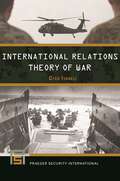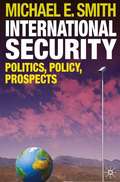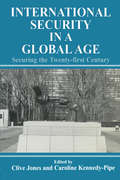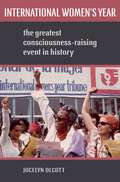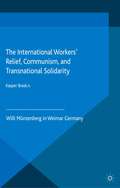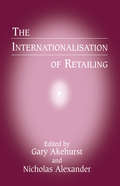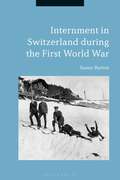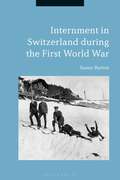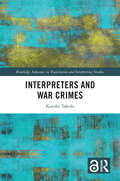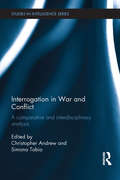- Table View
- List View
International Relations and the Origins of the Pacific War
by Ko UnokiInternational Relations and the Origins of the Pacific War takes the unique approach of examining the history of the relationship between Japan and the United States by using the framework of international relations theories to search for the origins of the Pacific War, that erupted with Japan's attack on Pearl Harbour in 1941.
International Relations Theory of War (Praeger Security International)
by Ofer IsraeliCovering 1816–2016, this book deals extensively with the international system as well as the territorial outcomes of several key wars that were waged during that time period, providing an instructive lesson in diplomatic history and international relations among global powers.Based on an in-depth review of the leading theories in the field of international relations, International Relations Theory of War explains an innovative theory on the international system, developed by the author, that he applies comprehensively to a large number of case studies. The book argues that there is a unipolar system that represents a kind of innovation relative to other systemic theories. It further posits that unipolar systems will be less stable than bipolar systems and more stable than multipolar systems, providing new insights relative to other theories that argue that unipolar systems are the most stable ones. The first chapter is devoted to explaining the manner of action of the two dependent variables—systemic international outcome and intra-systemic international outcome. The second chapter presents the international relations theory of war and its key assumptions. The third chapter precisely defines the distribution of power in the system. The fourth chapter examines the theory's two key phenomena. The fifth and last chapter presents the book's conclusions by examining the theoretical assumptions of the international relations theory of war.
International Relations Theory of War (Praeger Security International)
by Ofer IsraeliCovering 1816–2016, this book deals extensively with the international system as well as the territorial outcomes of several key wars that were waged during that time period, providing an instructive lesson in diplomatic history and international relations among global powers.Based on an in-depth review of the leading theories in the field of international relations, International Relations Theory of War explains an innovative theory on the international system, developed by the author, that he applies comprehensively to a large number of case studies. The book argues that there is a unipolar system that represents a kind of innovation relative to other systemic theories. It further posits that unipolar systems will be less stable than bipolar systems and more stable than multipolar systems, providing new insights relative to other theories that argue that unipolar systems are the most stable ones. The first chapter is devoted to explaining the manner of action of the two dependent variables—systemic international outcome and intra-systemic international outcome. The second chapter presents the international relations theory of war and its key assumptions. The third chapter precisely defines the distribution of power in the system. The fourth chapter examines the theory's two key phenomena. The fifth and last chapter presents the book's conclusions by examining the theoretical assumptions of the international relations theory of war.
International Sanctions: Between Wars and Words (Cass Series on Peacekeeping)
by Carina Staibano Peter WallensteenThe main theme of the book is that the new types of sanctions constitute a challenge to the international system. First, there are more of the targeted sanctions, including financial, travel, aviation, special commodity and arms sanctions. Furthermore, there are considerable but varied practices in implementation. Also there are now sanctions by new actors (regional bodies, international organizations). These all put new strains on international bodies in carrying out sanctions or getting member states to work together in these efforts. These challenges are analyzed in this volume, with some examples, but mostly from a generalist perspective. A completely novel aspect is that this volume also includes studies of the difficulties that are met by targeting actors, their way of managing the situations, and most interesting, the human rights of such actors.
International Sanctions: Between Wars and Words (Cass Series on Peacekeeping)
by Peter Wallensteen Carina StaibanoThe main theme of the book is that the new types of sanctions constitute a challenge to the international system. First, there are more of the targeted sanctions, including financial, travel, aviation, special commodity and arms sanctions. Furthermore, there are considerable but varied practices in implementation. Also there are now sanctions by new actors (regional bodies, international organizations). These all put new strains on international bodies in carrying out sanctions or getting member states to work together in these efforts. These challenges are analyzed in this volume, with some examples, but mostly from a generalist perspective. A completely novel aspect is that this volume also includes studies of the difficulties that are met by targeting actors, their way of managing the situations, and most interesting, the human rights of such actors.
International Security: Politics, Policy, Prospects (PDF)
by Michael E. SmithFrom war, terrorism and weapons of mass destruction, through environmental and economic crises, to epidemics, cyber-war and piracy, the twenty-first century world seems beset by a daunting range of international security problems.
International Security Issues in a Global Age: Securing the Twenty-first Century
by Clive JonesThis volume examines the new, the changing, and the enduring features of international security in the post-Cold War era. In so doing, it examines the extent to which present state structures and institutions have been able to adapt and accommodate themselves to the diversity of security threats.
International Security Issues in a Global Age: Securing the Twenty-first Century
by Clive Jones Caroline Kennedy-PipeThis volume examines the new, the changing, and the enduring features of international security in the post-Cold War era. In so doing, it examines the extent to which present state structures and institutions have been able to adapt and accommodate themselves to the diversity of security threats.
International Warbirds: An Illustrated Guide to World Military Aircraft, 1914-2000
by John C. FredriksenIn depth descriptions and photographs of the aircraft of 21 nations presented with a unique human dimension that goes behind the machines to the people involved.Invaluable for specialists, accessible to enthusiasts, International Warbirds: An Illustrated Guide to World Military Aircraft, 1914–2000 puts the most legendary fighter aircraft of the 20th century developed outside the United States on vivid display. It offers 336 illustrated "biographies" of the most significant warplanes used in squadron service from World War I to the Balkan conflict, including numerous models from Great Britain, France, Russia, and Japan, as well as notable machines from Israel, Canada, China, India, Brazil, and other nations.Entries span the history and scope of military aircraft from bombers and fighters to transports, trainers, reconnaissance craft, sea planes, and helicopters, with each capsule history combining nuts-and-bolts technical data with the story of that model's evolution and use. Together, these portraits offer an exciting, well-researched tribute to visionary designers and builders as well as courageous pilots and crews across the globe, and tell a vivid tale of how air power became such a decisive factor in modern warfare.
International Women's Year: The Greatest Consciousness-Raising Event in History
by Jocelyn OlcottAmid the geopolitical and social turmoil of the 1970s, the United Nations declared 1975 as International Women's Year. The capstone event, a two-week conference in Mexico City, was dubbed by organizers and journalists as "the greatest consciousness-raising event in history." The event drew an all-star cast of characters, including Soviet cosmonaut Valentina Tereshkova, Iranian Princess Ashraf Pahlavi, and US feminist Betty Friedan, as well as a motley array of policymakers, activists, and journalists. International Women's Year, the first book to examine this critical moment in feminist history, starts by exploring how organizers juggled geopolitical rivalries and material constraints amid global political and economic instability. The story then dives into the action in Mexico City, including conflicts over issues ranging from abortion to Zionism. The United Nations provided indispensable infrastructure and support for this encounter, even as it came under fire for its own discriminatory practices. While participants expressed dismay at levels of discord and conflict, Jocelyn Olcott explores how these combative, unanticipated encounters generated the most enduring legacies, including women's networks across the global south, greater attention to the intersectionalities of marginalization, and the arrival of women's micro-credit on the development scene. This watershed moment in transnational feminism, colorfully narrated in International Women's Year, launched a new generation of activist networks that spanned continents, ideologies, and generations.
International Women's Year: The Greatest Consciousness-Raising Event in History
by Jocelyn OlcottAmid the geopolitical and social turmoil of the 1970s, the United Nations declared 1975 as International Women's Year. The capstone event, a two-week conference in Mexico City, was dubbed by organizers and journalists as "the greatest consciousness-raising event in history." The event drew an all-star cast of characters, including Soviet cosmonaut Valentina Tereshkova, Iranian Princess Ashraf Pahlavi, and US feminist Betty Friedan, as well as a motley array of policymakers, activists, and journalists. International Women's Year, the first book to examine this critical moment in feminist history, starts by exploring how organizers juggled geopolitical rivalries and material constraints amid global political and economic instability. The story then dives into the action in Mexico City, including conflicts over issues ranging from abortion to Zionism. The United Nations provided indispensable infrastructure and support for this encounter, even as it came under fire for its own discriminatory practices. While participants expressed dismay at levels of discord and conflict, Jocelyn Olcott explores how these combative, unanticipated encounters generated the most enduring legacies, including women's networks across the global south, greater attention to the intersectionalities of marginalization, and the arrival of women's micro-credit on the development scene. This watershed moment in transnational feminism, colorfully narrated in International Women's Year, launched a new generation of activist networks that spanned continents, ideologies, and generations.
The International Workers’ Relief, Communism, and Transnational Solidarity: Willi Münzenberg in Weimar Germany (Palgrave Studies in the History of Social Movements)
by Kasper BraskénThe first major study on the making of new cultures, movements and public celebrations of transnational solidarity in Weimar Germany. The book shows how solidarity was used to empower the oppressed in their liberation and resistance movements and how solidarity networks transferred visions and ideas of an alternative global community.
The Internationalisation of Retailing
by G. Akehurst Nicholas AlexanderThe large retail enterprise which does not think on an international basis faces marginalization by competitors building international operations. Here, management researchers in the areas of international retailing offer an insight into the mechanisms of the internationalization of retailing.
The Internationalisation of Retailing
by Gary Akehurst Nicholas AlexanderThe large retail enterprise which does not think on an international basis faces marginalization by competitors building international operations. Here, management researchers in the areas of international retailing offer an insight into the mechanisms of the internationalization of retailing.
Internment during the First World War: A Mass Global Phenomenon (Routledge Studies in First World War History)
by Stefan Manz Panikos Panayi Matthew StibbeAlthough civilian internment has become associated with the Second World War in popular memory, it has a longer history. The turning point in this history occurred during the First World War when, in the interests of ‘security’ in a situation of total war, the internment of ‘enemy aliens’ became part of state policy for the belligerent states, resulting in the incarceration, displacement and, in more extreme cases, the death by neglect or deliberate killing of hundreds of thousands of people throughout the world. This pioneering book on internment during the First World War brings together international experts to investigate the importance of the conflict for the history of civilian incarceration.
Internment during the First World War: A Mass Global Phenomenon (Routledge Studies in First World War History)
by Panikos Panayi Matthew Stibbe Stefan ManzAlthough civilian internment has become associated with the Second World War in popular memory, it has a longer history. The turning point in this history occurred during the First World War when, in the interests of ‘security’ in a situation of total war, the internment of ‘enemy aliens’ became part of state policy for the belligerent states, resulting in the incarceration, displacement and, in more extreme cases, the death by neglect or deliberate killing of hundreds of thousands of people throughout the world. This pioneering book on internment during the First World War brings together international experts to investigate the importance of the conflict for the history of civilian incarceration.
Internment during the Second World War: A Comparative Study of Great Britain and the USA
by Rachel PistolThe internment of 'enemy aliens' during the Second World War was arguably the greatest stain on the Allied record of human rights on the home front. Internment during the Second World War compares and contrasts the experiences of foreign nationals unfortunate enough to be born in the 'wrong' nation when Great Britain, and later the USA, went to war. While the actions and policy of the governments of the time have been critically examined, Rachel Pistol examines the individual stories behind this traumatic experience. The vast majority of those interned in Britain were refugees who had fled religious or political persecution; in America, the majority of those detained were children. Forcibly removed from family, friends, and property, internees lived behind barbed wire for months and years. Internment initially denied these people the right to fight in the war and caused unnecessary hardships to individuals and families already suffering displacement because of Nazism or inherent societal racism. In the first comparative history of internment in Britain and the USA, memoirs, letters, and oral testimony help to put a human face on the suffering incurred during the turbulent early years of the war and serve as a reminder of what can happen to vulnerable groups during times of conflict. Internment during the Second World War also considers how these 'tragedies of democracy' have been remembered over time, and how the need for the memorialisation of former sites of internment is essential if society is not to repeat the same injustices.
Internment during the Second World War: A Comparative Study of Great Britain and the USA
by Rachel PistolThe internment of 'enemy aliens' during the Second World War was arguably the greatest stain on the Allied record of human rights on the home front. Internment during the Second World War compares and contrasts the experiences of foreign nationals unfortunate enough to be born in the 'wrong' nation when Great Britain, and later the USA, went to war. While the actions and policy of the governments of the time have been critically examined, Rachel Pistol examines the individual stories behind this traumatic experience. The vast majority of those interned in Britain were refugees who had fled religious or political persecution; in America, the majority of those detained were children. Forcibly removed from family, friends, and property, internees lived behind barbed wire for months and years. Internment initially denied these people the right to fight in the war and caused unnecessary hardships to individuals and families already suffering displacement because of Nazism or inherent societal racism. In the first comparative history of internment in Britain and the USA, memoirs, letters, and oral testimony help to put a human face on the suffering incurred during the turbulent early years of the war and serve as a reminder of what can happen to vulnerable groups during times of conflict. Internment during the Second World War also considers how these 'tragedies of democracy' have been remembered over time, and how the need for the memorialisation of former sites of internment is essential if society is not to repeat the same injustices.
Internment in Switzerland during the First World War
by Susan BartonIn contrast to the plethora of works focusing on the tragic loss of human lives during the First World War, little is known about the more hopeful realities of thousands of prisoners of war from Britain, France, Germany and Belgium who were sent to Switzerland from 1916. This book explores the everyday lives of these prisoners and their impact on Switzerland. Internees were warmly welcomed by local people and given education, training and employment. Leading relatively free lives, they were able to engage in leisure activities and develop new relationships. However, they also contributed to the country's economy, helping to keep Swiss tourism alive at a time when businesses were struggling and alleviating Switzerland's labour shortage as Swiss men were called-up to defend their borders and preserve the country's neutrality. Drawing on a wide range of sources from official records to magazines and postcards, Susan Barton provides an absorbing account of the social and cultural history of internment in Switzerland.
Internment in Switzerland during the First World War
by Susan BartonIn contrast to the plethora of works focusing on the tragic loss of human lives during the First World War, little is known about the more hopeful realities of thousands of prisoners of war from Britain, France, Germany and Belgium who were sent to Switzerland from 1916. This book explores the everyday lives of these prisoners and their impact on Switzerland. Internees were warmly welcomed by local people and given education, training and employment. Leading relatively free lives, they were able to engage in leisure activities and develop new relationships. However, they also contributed to the country's economy, helping to keep Swiss tourism alive at a time when businesses were struggling and alleviating Switzerland's labour shortage as Swiss men were called-up to defend their borders and preserve the country's neutrality. Drawing on a wide range of sources from official records to magazines and postcards, Susan Barton provides an absorbing account of the social and cultural history of internment in Switzerland.
The Interpreter
by Alice KaplanNo story of World War II is more triumphant than the liberation of France, made famous in countless photos of Parisians waving American flags and kissing GIs as columns of troops paraded down the Champs Élysées. But one of the least-known stories from that era is also one of the ugliest chapters in the history of Jim Crow. In The Interpreter, celebrated author Alice Kaplan recovers this story both as eyewitnesses first saw it, and as it still haunts us today. The American Army executed 70 of its own soldiers between 1943 and 1946—almost all of them black, in an army that was overwhelmingly white. Through the French interpreter Louis Guilloux’s eyes, Kaplan narrates two different trials: one of a white officer, one of a black soldier, both accused of murder. Both were court-martialed in the same room, yet the outcomes could not have been more different. Kaplan’s insight into character and setting creates an indelible portrait of war, race relations, and the dangers of capital punishment. “A nuanced historical account that resonates with today’s controversies over race and capital punishment.” Publishers Weekly “American racism could become deadly for black soldiers on the front. The Interpreter reminds us of this sad component of a heroic chapter in American military history.” Los Angeles Times “With elegance and lucidity, Kaplan revisits these two trials and reveals an appallingly separate and unequal wartime U.S. military justice system.” Minneapolis Star Tribune “Kaplan has produced a compelling look at the racial disparities as they were played out…She explores both cases in considerable and vivid detail.” Sacramento Bee
Interpreters and War Crimes (Routledge Advances in Translation and Interpreting Studies)
by Kayoko TakedaTaking an interdisciplinary approach, this book raises new questions and provides different perspectives on the roles, responsibilities, ethics and protection of interpreters in war while investigating the substance and agents of Japanese war crimes and legal aspects of interpreters’ taking part in war crimes. Informed by studies on interpreter ethics in conflict, historical studies of Japanese war crimes and legal discussion on individual liability in war crimes, Takeda provides a detailed description and analysis of the 39 interpreter defendants and interpreters as witnesses of war crimes at British military trials against the Japanese in the aftermath of the Pacific War, and tackles ethical and legal issues of various risks faced by interpreters in violent conflict. The book first discusses the backgrounds, recruitment and wartime activities of the accused interpreters at British military trials in addition to the charges they faced, the defence arguments and the verdicts they received at the trials, with attention to why so many of the accused were Taiwanese and foreign-born Japanese. Takeda provides a contextualized discussion, focusing on the Japanese military’s specific linguistic needs in its occupied areas in Southeast Asia and the attributes of interpreters who could meet such needs. In the theoretical examination of the issues that emerge, the focus is placed on interpreters’ proximity to danger, visibility and perceived authorship of speech, legal responsibility in war crimes and ethical issues in testifying as eyewitnesses of criminal acts in violent hostilities. Takeda critically examines prior literature on the roles of interpreters in conflict and ethical concerns such as interpreter neutrality and confidentiality, drawing on legal discussion of the ineffectiveness of the superior orders defence and modes of individual liability in war crimes. The book seeks to promote intersectoral discussion on how interpreters can be protected from exposure to manifestly unlawful acts such as torture.
Interpreters and War Crimes (Routledge Advances in Translation and Interpreting Studies)
by Kayoko TakedaTaking an interdisciplinary approach, this book raises new questions and provides different perspectives on the roles, responsibilities, ethics and protection of interpreters in war while investigating the substance and agents of Japanese war crimes and legal aspects of interpreters’ taking part in war crimes. Informed by studies on interpreter ethics in conflict, historical studies of Japanese war crimes and legal discussion on individual liability in war crimes, Takeda provides a detailed description and analysis of the 39 interpreter defendants and interpreters as witnesses of war crimes at British military trials against the Japanese in the aftermath of the Pacific War, and tackles ethical and legal issues of various risks faced by interpreters in violent conflict. The book first discusses the backgrounds, recruitment and wartime activities of the accused interpreters at British military trials in addition to the charges they faced, the defence arguments and the verdicts they received at the trials, with attention to why so many of the accused were Taiwanese and foreign-born Japanese. Takeda provides a contextualized discussion, focusing on the Japanese military’s specific linguistic needs in its occupied areas in Southeast Asia and the attributes of interpreters who could meet such needs. In the theoretical examination of the issues that emerge, the focus is placed on interpreters’ proximity to danger, visibility and perceived authorship of speech, legal responsibility in war crimes and ethical issues in testifying as eyewitnesses of criminal acts in violent hostilities. Takeda critically examines prior literature on the roles of interpreters in conflict and ethical concerns such as interpreter neutrality and confidentiality, drawing on legal discussion of the ineffectiveness of the superior orders defence and modes of individual liability in war crimes. The book seeks to promote intersectoral discussion on how interpreters can be protected from exposure to manifestly unlawful acts such as torture.
Interrogation in War and Conflict: A Comparative and Interdisciplinary Analysis (Studies in Intelligence)
by Christopher Andrew Simona TobiaThis edited volume offers a comparative and interdisciplinary analysis of interrogation and questioning in war and conflict in the twentieth century. Despite the current public interest and its military importance, interrogation and questioning in conflict is still a largely under-researched theme. This volume’s methodological thrust is to select historical case studies ranging in time from the Great War to the conflicts in former Yugoslavia, and including the Second World War, decolonization, the Cold War, the ‘Troubles’ in Northern Ireland and international justice cases in The Hague, each of which raises interdisciplinary issues about the role of interrogation. These case-studies were selected because they resurface previously unexplored sources on the topic, or revisit known cases which allow us to analyse the role of interrogation and questioning in intelligence, security and military operations. Written by a group of experts from a range of disciplines including history, intelligence, psychology, law and human rights, Interrogation in War and Conflict provides a study of the main turning points in interrogation and questioning in twentieth-century conflicts, over a wide geographical area. The collection also looks at issues such as the extent of the use of harsh techniques, the value of interrogation to military intelligence, security and international justice, the development of interrogation as a separate profession in intelligence, as well as the relationship between interrogation and questioning and wider society. This book will be of much interest to students of intelligence studies, strategic studies, counter-terrorism, international justice, history and IR in general.
Interrogation in War and Conflict: A Comparative and Interdisciplinary Analysis (Studies in Intelligence)
by Christopher Andrew Simona TobiaThis edited volume offers a comparative and interdisciplinary analysis of interrogation and questioning in war and conflict in the twentieth century. Despite the current public interest and its military importance, interrogation and questioning in conflict is still a largely under-researched theme. This volume’s methodological thrust is to select historical case studies ranging in time from the Great War to the conflicts in former Yugoslavia, and including the Second World War, decolonization, the Cold War, the ‘Troubles’ in Northern Ireland and international justice cases in The Hague, each of which raises interdisciplinary issues about the role of interrogation. These case-studies were selected because they resurface previously unexplored sources on the topic, or revisit known cases which allow us to analyse the role of interrogation and questioning in intelligence, security and military operations. Written by a group of experts from a range of disciplines including history, intelligence, psychology, law and human rights, Interrogation in War and Conflict provides a study of the main turning points in interrogation and questioning in twentieth-century conflicts, over a wide geographical area. The collection also looks at issues such as the extent of the use of harsh techniques, the value of interrogation to military intelligence, security and international justice, the development of interrogation as a separate profession in intelligence, as well as the relationship between interrogation and questioning and wider society. This book will be of much interest to students of intelligence studies, strategic studies, counter-terrorism, international justice, history and IR in general.

